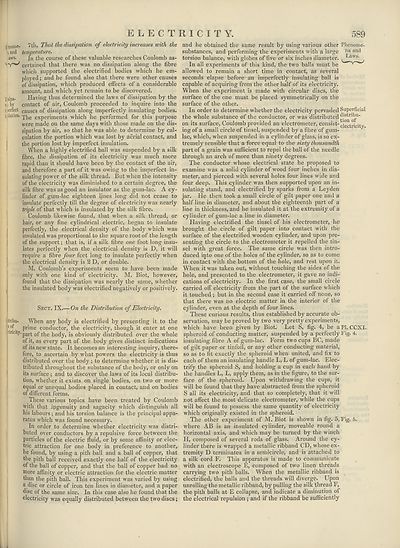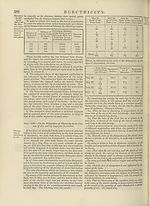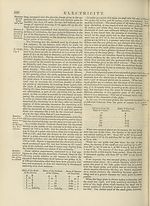Encyclopaedia Britannica > Volume 8, DIA-England
(599) Page 589
Download files
Complete book:
Individual page:
Thumbnail gallery: Grid view | List view

ELECTRICITY.
589
] nonic- 7tl), That the dissipation of electricity increases with the
i and temperature.
aws. in the course of these valuable researches Coulomb as-
certained that there was no dissipation along the fibre
which supported the electrified bodies which he em¬
ployed; and he found also that there were other causes
of dissipation, which produced effects of a considerable
amount, and which yet remain to be discovered.
]3ipa- Having thus determined the laws of dissipation by the
t by contact of air, Coulomb proceeded to inquire into the
i effect causes of dissipation along imperfectly insulating bodies,
i: ilation. experiments which he performed for this purpose
were made on the same days with those made on the dis¬
sipation by air, so that he was able to determine by cal¬
culation the portion which was lost by aerial contact, and
the portion lost by imperfect insulation.
When a highly electrified ball was suspended by a silk
fibre, the dissipation of its electricity was much more
rapid than it should have been by the contact of the air,
and therefore a part of it was owing to the imperfect in¬
sulating power of the silk thread. But when the intensity
of the electricity was diminished to a certain degree, the
silk fibre was as good an insulator as the gum-lac. A cy¬
linder of gum-lac eighteen lines long did not cease to
insulate perfectly till the degree of electricity was nearly
triple of that which is insulated by the silk fibre.
Coulomb likewise found, that when a silk thread, or
hair, or any fine cylindrical electric, began to insulate
perfectly, the electrical density of the body which was
insulated was proportional to the square root of the length
of the support; that is, if a silk fibre one foot long insu¬
lates perfectly when the electrical density is D, it will
require a fibre four feet long to insulate perfectly when
the electrical density is 2 D, or double.
M. Coulomb’s experiments seem to have been made
only with one kind of electricity. M. Biot, however,
found that the dissipation was nearly the same, whether
the insulated body was electrified negatively or positively.
Sect. IX.— On the Distribution of Electricity.
itribu- When any body is electrified by presenting it to the
I °f, prime conductor, the electricity, though it enter at one
-tncity.part 0f b0(iy} js obviously distributed over the whole
of it, as every part of the body gives distinct indications
of its new state. It becomes an interesting inquiry, there¬
fore, to ascertain by what powers the electricity is thus
distributed over the body ; to determine whether it is dis¬
tributed throughout the substance of the body, or only on
its surface; and to discover the laws of its local distribu¬
tion, whether it exists on single bodies, on two or more
equal or unequal bodies placed in contact, and on bodies
of different forms.
These various topics have been treated by Coulomb
with that ipgenuity and sagacity which distinguish all
his labours ; and his torsion balance is the principal appa¬
ratus which was found necessary.
In order to determine whether electricity was distri¬
buted over conductors by a repulsive force between the
particles of the electric fluid, or by some affinity or elec¬
tric attraction for one body in preference to another,
he found, by using a pith ball and a ball of copper, that
the pith ball received exactly one half of the electricity
of the ball of copper, and that the ball of copper had no
more affinity or electric attraction for the electric matter
than the pith ball. This experiment was varied by using
a disc or circle of iron ten lines in diameter, and a paper
disc of the same size. In this case also he found that the
electricity was equally distributed between the two discs;
and he obtained the same result by using various other Phenome-
substances, and performing tbe experiments with a large na and
torsion balance, with globes of five or six inches diameter. t Haws. ^
In all experiments of this kind, the two balls must be
allowed to remain a short time in contact, as several
seconds elapse before an imperfectly insulating ball is
capable of acquiring from the other half of its electricity.
When the experiment is made with circular discs, the
surface of the one must be placed symmetrically on the
surface of the other.
In order to determine whether the electricity pervaded Superficial
the whole substance of the conductor, or was distributed^®*1^!1*
on its surface, Coulomb provided an electrometer, consist-^ectl.-c;t
ing of a small circle of tinsel, suspended by a fibre of gum-
lac, which, when suspended in a cylinder of glass, is so ex¬
tremely sensible that a force equal to the sixty thousandth
part of a grain was sufficient to repel the ball of the needle
through an arch of more than ninety degrees.
The conductor whose electrical state he proposed to
examine was a solid cylinder of wood four inches in dia¬
meter, and pierced with several holes four lines wide and
four deep. This cylinder was then supported upon an in¬
sulating stand, and electrified by sparks from a Leyden
jar. He then took a small circle of gilt paper one and a
half line in diameter, and about tbe eighteenth part of a
line in thickness, and he insulated it at the exti'emity of a
cylinder of gum-lac a line in diameter.
Having electrified the tinsel of his electrometer, he
brought the circle of gilt paper into contact with the
surface of the electrified wooden cylinder, and upon pre¬
senting the circle to the electrometer it repelled the tin¬
sel with great force. The same circle was then intro¬
duced into one of the holes of the cylinder, so as to come
in contact with the bottom of the hole, and rest upon it.
When it was taken out, without touching the sides of the
hole, and presented to the electrometer, it gave no indi¬
cations of electricity. In the first case, the small circle
carried off electricity from the part of the surface which
it touched ; but in the second case it carried off none, so
that there was no electric matter in the interior of the
cylinder, even at the depth of four lines.
These curious results, thus established by accurate ob¬
servation, may be proved by two very pretty experiments,
which have been given by Biot. Let S, fig. 4, be a PI. CCXI.
spheroid of conducting matter, suspended by a perfectly Fig* 4.
insulating fibre A of gum-lac. Form two cups BC, made
of gilt paper or tinfoil, or any other conducting material,
so as to fit exactly the spheroid when united, and fix to
each of them an insulating handle L, L of gum-lac. Elec¬
trify the spheroid S, and holding a cup in each hand by
the handles L, L, apply them, as in the figure, to the sur¬
face of the spheroid. Upon withdrawing the cups, it
will be found that they have abstracted from the spheroid
S all its electricity, and that so completely, that it will
not affect the most delicate electrometer, while the cups
will be found to possess the same quantity of electricity
which originally existed in the spheroid.
The other experiment of M. Biot is shown in fig. 5, Fig. 5.
where AB is an insulated cylinder, moveable round a
horizontal axis, and which may be turned by the winch
H, composed of several rods of glass. Around the cy¬
linder there is wrapped a metallic ribband CD, whose ex¬
tremity D terminates in a semicircle, and is attached to
a silk cord F. This apparatus is made to communicate
with an electroscope E, composed of two linen threads
carrying two pith balls. When the metallic ribband is
electrified, the balls and the threads will diverge. Upon
unrolling the metallic ribband, by pulling the silk thread F,
the pith balls at E collapse, and indicate a diminution of
the electrical repulsion ; and if the ribband be sufficiently
589
] nonic- 7tl), That the dissipation of electricity increases with the
i and temperature.
aws. in the course of these valuable researches Coulomb as-
certained that there was no dissipation along the fibre
which supported the electrified bodies which he em¬
ployed; and he found also that there were other causes
of dissipation, which produced effects of a considerable
amount, and which yet remain to be discovered.
]3ipa- Having thus determined the laws of dissipation by the
t by contact of air, Coulomb proceeded to inquire into the
i effect causes of dissipation along imperfectly insulating bodies,
i: ilation. experiments which he performed for this purpose
were made on the same days with those made on the dis¬
sipation by air, so that he was able to determine by cal¬
culation the portion which was lost by aerial contact, and
the portion lost by imperfect insulation.
When a highly electrified ball was suspended by a silk
fibre, the dissipation of its electricity was much more
rapid than it should have been by the contact of the air,
and therefore a part of it was owing to the imperfect in¬
sulating power of the silk thread. But when the intensity
of the electricity was diminished to a certain degree, the
silk fibre was as good an insulator as the gum-lac. A cy¬
linder of gum-lac eighteen lines long did not cease to
insulate perfectly till the degree of electricity was nearly
triple of that which is insulated by the silk fibre.
Coulomb likewise found, that when a silk thread, or
hair, or any fine cylindrical electric, began to insulate
perfectly, the electrical density of the body which was
insulated was proportional to the square root of the length
of the support; that is, if a silk fibre one foot long insu¬
lates perfectly when the electrical density is D, it will
require a fibre four feet long to insulate perfectly when
the electrical density is 2 D, or double.
M. Coulomb’s experiments seem to have been made
only with one kind of electricity. M. Biot, however,
found that the dissipation was nearly the same, whether
the insulated body was electrified negatively or positively.
Sect. IX.— On the Distribution of Electricity.
itribu- When any body is electrified by presenting it to the
I °f, prime conductor, the electricity, though it enter at one
-tncity.part 0f b0(iy} js obviously distributed over the whole
of it, as every part of the body gives distinct indications
of its new state. It becomes an interesting inquiry, there¬
fore, to ascertain by what powers the electricity is thus
distributed over the body ; to determine whether it is dis¬
tributed throughout the substance of the body, or only on
its surface; and to discover the laws of its local distribu¬
tion, whether it exists on single bodies, on two or more
equal or unequal bodies placed in contact, and on bodies
of different forms.
These various topics have been treated by Coulomb
with that ipgenuity and sagacity which distinguish all
his labours ; and his torsion balance is the principal appa¬
ratus which was found necessary.
In order to determine whether electricity was distri¬
buted over conductors by a repulsive force between the
particles of the electric fluid, or by some affinity or elec¬
tric attraction for one body in preference to another,
he found, by using a pith ball and a ball of copper, that
the pith ball received exactly one half of the electricity
of the ball of copper, and that the ball of copper had no
more affinity or electric attraction for the electric matter
than the pith ball. This experiment was varied by using
a disc or circle of iron ten lines in diameter, and a paper
disc of the same size. In this case also he found that the
electricity was equally distributed between the two discs;
and he obtained the same result by using various other Phenome-
substances, and performing tbe experiments with a large na and
torsion balance, with globes of five or six inches diameter. t Haws. ^
In all experiments of this kind, the two balls must be
allowed to remain a short time in contact, as several
seconds elapse before an imperfectly insulating ball is
capable of acquiring from the other half of its electricity.
When the experiment is made with circular discs, the
surface of the one must be placed symmetrically on the
surface of the other.
In order to determine whether the electricity pervaded Superficial
the whole substance of the conductor, or was distributed^®*1^!1*
on its surface, Coulomb provided an electrometer, consist-^ectl.-c;t
ing of a small circle of tinsel, suspended by a fibre of gum-
lac, which, when suspended in a cylinder of glass, is so ex¬
tremely sensible that a force equal to the sixty thousandth
part of a grain was sufficient to repel the ball of the needle
through an arch of more than ninety degrees.
The conductor whose electrical state he proposed to
examine was a solid cylinder of wood four inches in dia¬
meter, and pierced with several holes four lines wide and
four deep. This cylinder was then supported upon an in¬
sulating stand, and electrified by sparks from a Leyden
jar. He then took a small circle of gilt paper one and a
half line in diameter, and about tbe eighteenth part of a
line in thickness, and he insulated it at the exti'emity of a
cylinder of gum-lac a line in diameter.
Having electrified the tinsel of his electrometer, he
brought the circle of gilt paper into contact with the
surface of the electrified wooden cylinder, and upon pre¬
senting the circle to the electrometer it repelled the tin¬
sel with great force. The same circle was then intro¬
duced into one of the holes of the cylinder, so as to come
in contact with the bottom of the hole, and rest upon it.
When it was taken out, without touching the sides of the
hole, and presented to the electrometer, it gave no indi¬
cations of electricity. In the first case, the small circle
carried off electricity from the part of the surface which
it touched ; but in the second case it carried off none, so
that there was no electric matter in the interior of the
cylinder, even at the depth of four lines.
These curious results, thus established by accurate ob¬
servation, may be proved by two very pretty experiments,
which have been given by Biot. Let S, fig. 4, be a PI. CCXI.
spheroid of conducting matter, suspended by a perfectly Fig* 4.
insulating fibre A of gum-lac. Form two cups BC, made
of gilt paper or tinfoil, or any other conducting material,
so as to fit exactly the spheroid when united, and fix to
each of them an insulating handle L, L of gum-lac. Elec¬
trify the spheroid S, and holding a cup in each hand by
the handles L, L, apply them, as in the figure, to the sur¬
face of the spheroid. Upon withdrawing the cups, it
will be found that they have abstracted from the spheroid
S all its electricity, and that so completely, that it will
not affect the most delicate electrometer, while the cups
will be found to possess the same quantity of electricity
which originally existed in the spheroid.
The other experiment of M. Biot is shown in fig. 5, Fig. 5.
where AB is an insulated cylinder, moveable round a
horizontal axis, and which may be turned by the winch
H, composed of several rods of glass. Around the cy¬
linder there is wrapped a metallic ribband CD, whose ex¬
tremity D terminates in a semicircle, and is attached to
a silk cord F. This apparatus is made to communicate
with an electroscope E, composed of two linen threads
carrying two pith balls. When the metallic ribband is
electrified, the balls and the threads will diverge. Upon
unrolling the metallic ribband, by pulling the silk thread F,
the pith balls at E collapse, and indicate a diminution of
the electrical repulsion ; and if the ribband be sufficiently
Set display mode to:
![]() Universal Viewer |
Universal Viewer | ![]() Mirador |
Large image | Transcription
Mirador |
Large image | Transcription
Images and transcriptions on this page, including medium image downloads, may be used under the Creative Commons Attribution 4.0 International Licence unless otherwise stated. ![]()
| Encyclopaedia Britannica > Encyclopaedia Britannica > Volume 8, DIA-England > (599) Page 589 |
|---|
| Permanent URL | https://digital.nls.uk/193330792 |
|---|
| Attribution and copyright: |
|
|---|
| Description | Ten editions of 'Encyclopaedia Britannica', issued from 1768-1903, in 231 volumes. Originally issued in 100 weekly parts (3 volumes) between 1768 and 1771 by publishers: Colin Macfarquhar and Andrew Bell (Edinburgh); editor: William Smellie: engraver: Andrew Bell. Expanded editions in the 19th century featured more volumes and contributions from leading experts in their fields. Managed and published in Edinburgh up to the 9th edition (25 volumes, from 1875-1889); the 10th edition (1902-1903) re-issued the 9th edition, with 11 supplementary volumes. |
|---|---|
| Additional NLS resources: |
|

